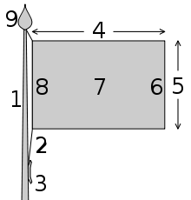
Since many years, Flagsonline.it supplies advices to our customers helping them to show world's flags in the best way, avoiding errors that we often see along streets in Italy and in the entire world. We must say that every Country has is own protocol that is a mass of rules and habits to follow during public or private ceremonies. Italy has a Ceremony service (Office of Nation Ceremonial) that minds about events in which The President of the Italian Republic and Prime Minister take place.
Besides it minds about rules for flags positioning. This office works under Italian Government and Prime Minister dispositions. Even though Ceremonial regulates the flags position for public buildings (prefectures, schools, barracks, etc.) a good practice for companies and privates is to follow those official rules. Every single flag has its intrinsic value so it's better if its positioning was not random. A special thanks goes to Roberto Breschi, CISV's President and Raffaello Michellotti CISV's member.
The flag can be divided into quadrants: the two dials on the left are called "auction" because they are the dials behind the rod, while the two on the right are called "to the knocker" because positioned where the flag slams or waves. Another very used term is canton, always referred to the quadrants. The canton at the top of the auction is known as the "first quadrant".

Here are other terms used to talk about flags.
Downhaul: It is the lower rope of the flag, which is usually linked up to the pulley so that the flag remains taut, once hoisted.
Vexilloid: a flag-like object that is used in a similar symbolic manner as a flag.
Courtesy flag or courtesy ensign: a flag that is flown on a visiting ship in foreign waters as a sign of respect for the foreign nation.
Naval flag: It is the emblem and the symbol of the nationality of the ship and of the sovereignty of the state to which it belongs. The naval flag is hoisted at the stern auction, at the peak of the aft mast or at the outer rope of the main cross of the single mast. Sometimes the naval flag is lifted to the stern pole during ceremonies, or entry or exit from ports (particularly abroad).
Signal flag: a flag or pennant that communicates or signals information that is not heraldic.
Standard: in heraldry, a long tapering flag that bears heraldic badges and the motto of the armiger.
Prayer flag: a kind of flag that is flown along mountain ridges and peaks in the Himalayas in order to bless the surrounding land.
War flag or military flag: a variant of a national flag that a nation's military forces use on land.
Jack Flag: a jack is a national (originally naval) flag flown from a short jackstaff at the bow of a vessel, while the ensign is flown on the stern.
Distress: Flying the flag upside-down or tying it into a wheft.
Half-mast: a style of flag display where the flag is flown at least the width of the flag between the top of the flag and the top of the pole.
Hoist: the act or function of raising a flag, as on a rope.
Lower: the act or function of taking down a flag, as on a rope.